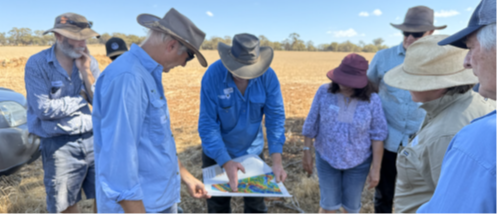
The field day provided an engaging, hands-on exploration of the interconnected roles of water, plants, solar radiation, and gravity in shaping landscapes. Participants gained insights into how water moves through various terrains, how ecosystems respond to intervention, and how we can work with natural processes to restore degraded land.
On Monday 31 March participants gathered at a farm in Cuballing for a Landscape Rehydration Field Day.
The event included technical, theoretical, and practical in-field demonstrations exploring how water moves through a landscape. Mulloon institute Landscape Planner and Hydrologist Lance Mudgway delivered a comprehensive explanation of the water cycle, highlighting the relationship between water, plants, solar radiation, and gravity. In the field, participants had the opportunity to assess the landscape, identify patterns and processes, and deepen their understanding of soil and water interactions. Key discussions focused on salinity, erosion, and how these challenges can be addressed through planning and design to achieve sustainable water conservation
Key Learnings
Water, Plants, and Gravity: Drivers of Landscape Change
We explored how solar radiation drives the water cycle through evaporation, while gravity pulls water downhill. This interaction governs how water infiltrates soil, supports plant life, or causes erosion. Plants play a critical role in this system by stabilizing soil, regulating water movement, and reducing surface temperatures through canopy cover.
Water Movement Through Landscapes
From ridgelines to riverbeds, we followed the flow of water, observing how it collects, infiltrates, or runs off depending on topography, soil condition, and vegetation. Key focus areas included overland flow, infiltration zones, and drainage lines, all of which influence erosion and salinity risks.
Landscape Assessment
Participants were guided in reading the land’s history and context using: Vegetation patterns, Soil surface condition, Hydrological features and Local knowledge and past land use. This helped develop an understanding of landscape trajectory – whether the system is degrading, stable, or recovering.
Understanding Soil
We discussed and examined: Soil texture (sand, silt, clay), Soil structure, Organic matter content, Infiltration rates. Healthy soil with good structure and organic matter supports plant growth, improves infiltration, and resists erosion.
Soil-Water Interaction and Vegetation
We emphasized the importance of maintaining ground cover and organic matter. Bare soil is highly vulnerable to erosion and salinity. Participants compared mulched vs. bare surfaces, reinforcing how plants and litter layer act as buffers, supporting microbial activity and slowing water.
Erosion, Salinity, and Feedback Loops
We discussed how exposed soils and waterlogging create positive feedback loops that worsen degradation. For example: Erosion → Loss of plants → More erosion
Rising water tables → Salinity → Loss of ground cover → More salinity
Understanding these loops helps identify where and when to intervene.
Principles of Planning and Design
We introduced the core design principles for working with landscapes: Imitate nature (e.g., contouring, meandering flows), Start small and observe outcomes (low-risk intervention), Intervene only when necessary, particularly when degradation is active or the landscape is trending downward
On-ground examples showed how to: Slow, spread, and sink water using swales, brush weirs, and micro-catchments, stabilise gullies and trap sediment near the source, revegetate key areas to restore natural processes.
Learnt the concept of manage land in three zones: Uplands – increase infiltration, reduce runoff, Mid-slopes – stabilize erosion and enhance cover, Lowlands – trap sediment, rehydrate wetlands
Final Reflections
Participants left with a stronger understanding of how to read, respect, and work with the land. By observing natural patterns, respecting water flow, and reinforcing the role of plants and soil, we can guide degraded landscapes onto a regenerative path.
“Grow more plants, keep water fresh, hold the soil, and let nature lead the way.”
A special thank you to Mike Burges for hosting us for this event.
For further information and resources, visit The Mulloon Institute at
https://www.themullooninstitute.org
This project is supported by the Sustainable Agriculture Position and the Australian Government through funding from the National Heritage Trust under the Climate-Smart Agriculture Program.
